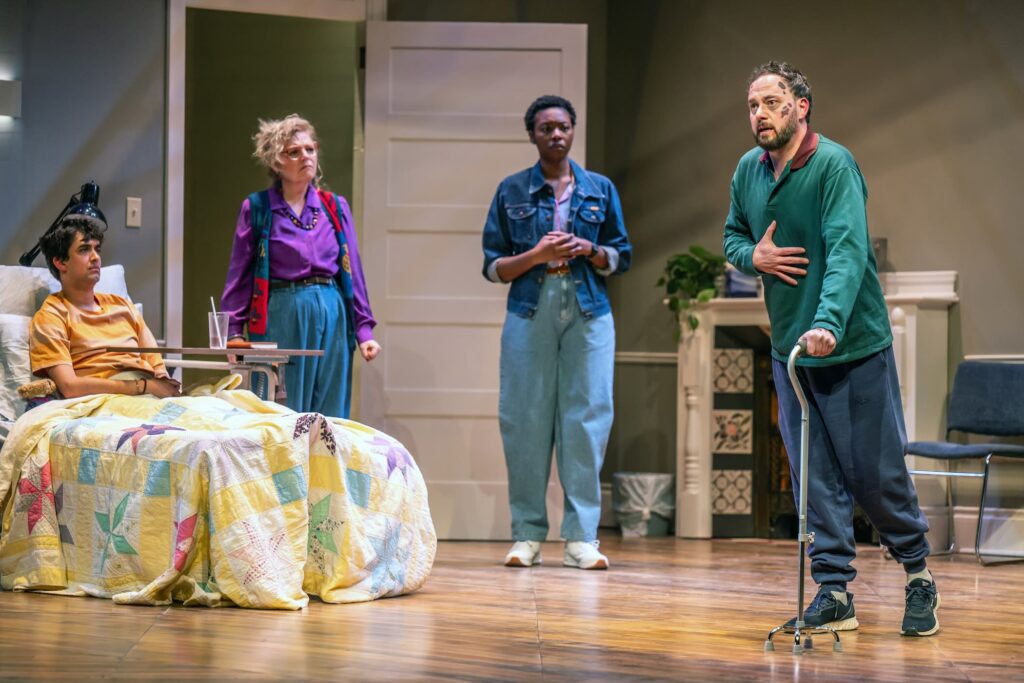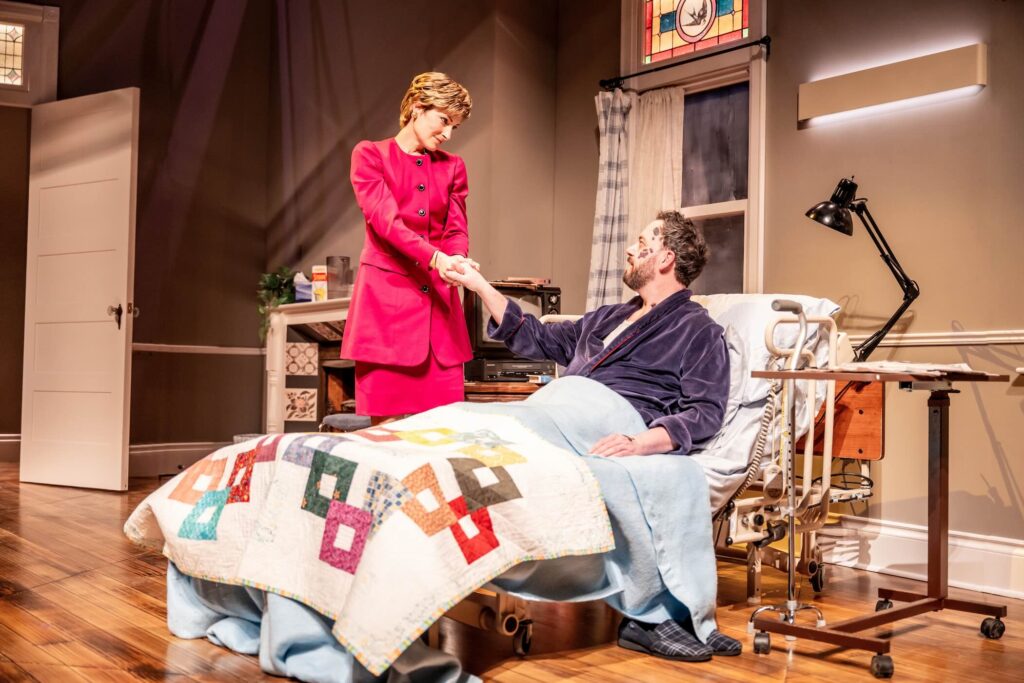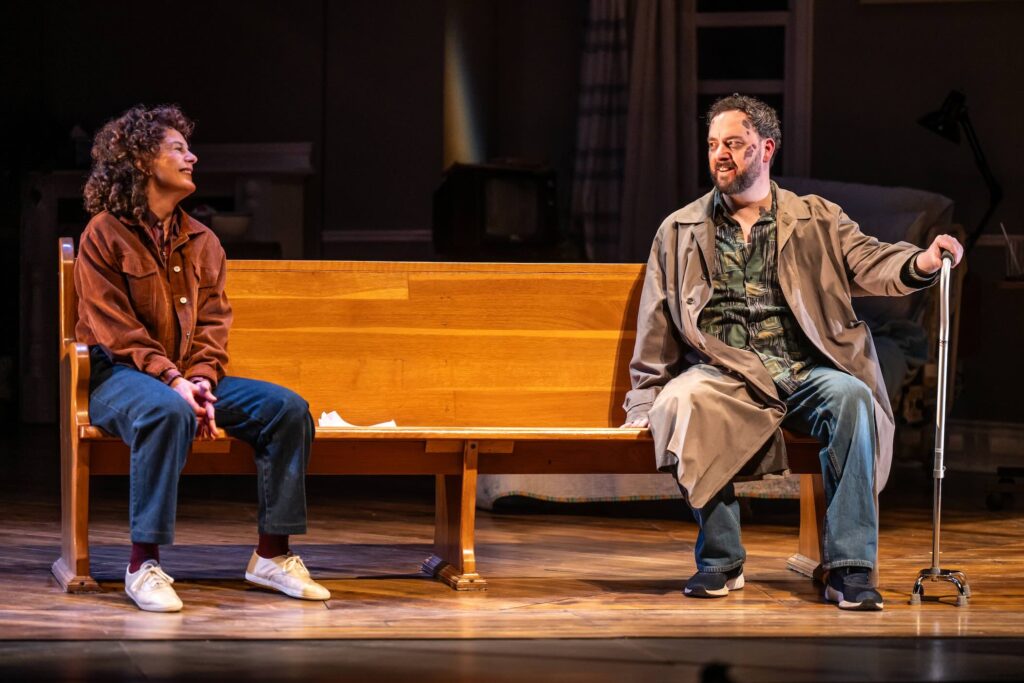REVIEW: Casey and Diana is powerful, gripping, funny and hopeful

This play, set at the height of fear and death caused by the AIDS pandemic, will stick with you long after you leave the theatre.
How do you manage to live when you are dying? How do you navigate relationships and find compassion in an era of fear? How do you learn to die when life is messy, complicated, painful and mundane?
Theatre Aquarius presents an emotionally powerful and gripping story about life in the face of death and grief.
Hope is a complex commodity for the characters in Casey and Diana, written by playwright Nick Green and presented here as a co-production with The Royal Manitoba Theatre Centre.
It’s 1991, and Toronto’s Casey House is still in its first five years of operation as Canada’s first stand-alone treatment facility for people living with HIV/AIDS. Its founder, June Callwood, wanted to provide people dying of AIDS with a “velvet experience,” as director Andrew Kushnir says, “a soft, warm, home-like space for a far-too-hard way to go.”
In a moment of truth telling, lead character and Casey House’s longest resident Thomas (Gregory Prest) levels with us: the situation in which people find themselves residents of Casey House is “terribly, terribly sad.” There’s no escape; there’s no getting better during this chapter of the pandemic. Mercifully, there have been leaps in the treatment of HIV/AIDS since then, allowing for the possibility of management, greater quality of life, and reframing as a chronic condition instead of a terminal diagnosis.

But this isn’t what Thomas and angry new arrival Andre (Noah Beemer) can expect in the early ’90s. Instead, Casey House strives to meet its residents in the breach and help them die with dignity, care, and community. This was no small feat or gift. As Kushnir writes in his director’s notes, “People with AIDS at this time died social deaths first.”
Despite the inevitable outcome, despite the painful and sometimes frightening symptoms of decline, Casey and Diana is not a morbid or melodramatic play. Green has crafted a deeply moving script with evocative and layered characters and a story that rings true with a healthy dose of humour to offset the pain. And then there’s news that evokes no small amount of hope and anticipation: Princess Diana will visit Casey House in one week’s time and meet the residents. No, not one week. Seven days. Seven days of hours, and minutes, and moments to endure to reach her arrival.
Prest is mesmerizing, charming, and so very likable in his role as Thomas, a socially gregarious, witty and caustic patient with noticeable lesions on his face. He has a penchant for quoting Steel Magnolias and fondly remembers watching Diana’s wedding with his now-estranged sister, Pauline (Alicia Johnston).
He’s excited by news of the visit, then stops our hearts with a remark to Casey House nurse Vera: “I wasn’t planning on being here next week.” Nevertheless, he is inspired by the impending visit, spurred to leave his bed, take more and more ambitious walks, and motivate the other residents to make it to the day of the Princess’s arrival.
Read our interviews with Casey and Diana's lead actors!
Vera, played by Gloria Mampuya, is a quiet, calm, and capable nurse; she’s measured, seemingly unflappable, and frequently arrives just when she’s needed most to support the residents of Casey House. She also maintains an aura of disapproval when it comes to Marjorie (Sharon Bajer), the jovial, intense, very invested volunteer who has been with Casey House for a month. It’s not until the second act that Vera’s controlled façade falters, and we are riveted as she reveals the true cost for those who work at the hospice.
This is after a frightening episode young Andre experiences, when it seems likely that he will succumb to this terrible illness, aching for the family who has cast him out. Marjorie is overtaken by a desperate grief, climbing on his bed and wailing, triggered by the unresolved heartache she still holds for her best friend, a man she cared for until his death not so long ago. I found myself reacting to Marjorie’s actions with sudden anger: “This isn’t about you! This is his death.”
It is a testament to the depth of Bajer’s performance that I found myself struggling with Marjorie’s expression of her own pain in the face of Andre’s death and her all-too-realistic and well-meaning trampling of boundaries.

Set and costume designer Joshua Quinlan was also the designer for the original Stratford run of Casey and Diana. The raked stage was well appointed and used the expanse of the stage to evoke rooms at Casey House as well as other locations.
His costumes are understated and period appropriate, and the tailored suits worn by Princess Diana particularly stand out as picture perfect in representing one of the most photographed women in history.
Wearing these outfits, Catherine Wreford’s breathtaking achievement in posture and physicality allows the audience to believe that Princess Diana is really walking among us. Several actors have, in recent years, risen to the daunting challenge of embodying Diana, including Kristen Stewart, Emma Corrin, and Elizabeth Debicki. Wreford manages to strike a seemingly impossible balance in having Diana seem understated in moments when it’s Thomas and his dialogue that is truly the focus, and heartstopping in moments when she wordlessly moves across the stage.
More than anything, Diana is a symbol within the play: a symbol of hope, yearning, compassion, love, the fleetingness of time, and the light that illuminates the residents and those around them.
Several times there are references to opening the window in Andre and Thomas’s room. Diana’s presence in the story and the impact of her coming visit serves to open a window between Casey House and the rest of the world, and to open the story and characters’ consciousness to larger ideas of life, death, longing, absolution, and connection.
Before watching Casey and Diana, I knew that many viewers of the original production as well as the preview performances at Theatre Aquarius had experienced deeply emotional reactions. This was especially the case for people who had reached adulthood through the ’80s and ’90s or had a personal connection to the AIDS pandemic, with often multiple losses they still grieve.
At several moments, the audience was pin-drop silent as the story unfolded. In the last moments, we collectively held our breath.
Now in my early 50s, I remember when people mused about whether it was safe to touch or hug or kiss a person with AIDS, an era of stigma and “othering” when the public wasn’t certain if toilet seats were dangerous or if a sneeze or drop of blood was enough to condemn someone to death.
It seems almost quaint now to think that an English princess making a photo call at a Canadian AIDS hospice could have the seismic impact that it did, but Diana’s ability to connect with people and represent a spirit of tenderness and compassion was already legendary. If this beautiful young princess could touch, embrace, and hold the hands of these individuals, then the rest of us could fix our hearts and reach out, too.

This play has stuck with me over a few days, and not simply because I was assigned to review it. It has taken some time to digest it and this will continue, I think, for some time to come. Certainly, not all plays have that kind of effect.
Of course, the subject matter reverberates strongly in the years following another catastrophic pandemic. Casey and Diana, which debuted in 2023 and was staged again at Soulpepper in Toronto in 2024, unearths the fear of contagion, the loneliness of stay-home orders and the touch-hunger of social distancing, and feelings of powerlessness and grief over the loss of loved ones that all remains raw today.
So when Thomas recounts the pain of how his sister Pauline physically recoiled and then abandoned him when she found out about his diagnosis, it feels a bit more recognizable in a post(?)-COVID world. When she flinches and hesitates, and later when she admits to emotional burnout at a never-ending cycle of funerals, it may not be the same song, but we notice a few similar chords. Pauline becomes a flawed but well-meaning human desperate for her brother’s forgiveness before he slips away, rather than a heartless villain who abandoned him when he needed her most.
Casey and Diana is a tender, complex, and compelling celebration of courage, community, and love, and the resilience of the human spirit.
The productions at Stratford, Soulpepper, and Theatre Aquarius have each included the display of commemorative quilts and the ability to craft a decorative heart to add to a Paper Quilt Wall sharing names of loved ones lost and remembered. There’s a quiet space for reflection offered in the Director’s Lounge upstairs.
Director Andrew Kushnir says eloquently that “there are still many folks among us both actively and passively grieving the early AIDs era,” and that in “making a space for grief” and “bringing it into community,” Casey and Diana can help us all “speak, and laugh, and cry, and remember, and somehow, together, in the dark, feel that little bit lighter.”
Casey and Diana continues until March 8 at Theatre Aquarius. Tickets are here.












